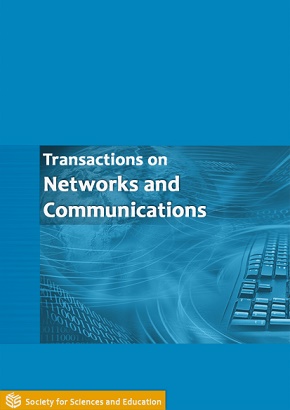Enhancement of Maximal Ratio Combiner over Log-Normal Fading Channel using Firefly Algorithm
DOI:
https://doi.org/10.14738/tnc.72.6214Keywords:
Firefly Algorithm (FA), Maximum Ratio Combiner (MRC), Bit Error Rate (BER), Square Root Raise Cosine (SRRC) filter, log-normal fading channel.Abstract
Wireless communication system has a great impact in the world of telecommunication and is expected to be a leading role in the developing a nation. However, the system is characterized by multipath propagation effects that lead to signal fluctuation at the receiver, thereby degrading the performance of the system. Maximal Ratio Combiner (MRC) being used to address this problem is characterized with hardware complexity that results in long processing time. Therefore, in this paper enhancement of MRC with closed form expression over Log-Normal fading channel is carried out using Firefly Algorithm (FA) at the receiver. FA create a flashing light in associated with Signal to Noise Ratio (SNR) of the received signal and output the signal with highest SNR. Randomly generated bits used as source data are modulated using M-ary Quadrature Amplitude Modulation (M-QAM) and transmitted over Log-Normal fading channel to generate resultant signals. The resultant signals at varying paths ‘L’ (2, 3, 4) are optimized by FA. The outputs of the FA are combined by MRC to obtain the received signal and converted to baseband through demodulation. A mathematical expression using the Probability Density Function (PDF) of Log-Normal fading channel at varying paths ’L’ for Bit Error Rate (BER) is also derived. The technique is simulated using MATLAB 7.4. The performance is evaluated using Signal-to-Noise Ratio (SNR), Bit Error Rate (BER) and Processing Time (PT). The result shows that, the enhanced MRC (eMRC) gave lower BER values when compared with conventional MRC with reduction in hardware complexity. The eMRC carried out can be used to enhance the performance of wireless communication system.
References
(1) Adil H., Nishant G. and Divya G. Firefly Algorithm for Unconstrained Optimization. Journal of Computer Engineering. 11(1). PP 75-78 (2013).
(2) Nadhirah A., Mohd A. O., Mohd N. H. and Mohamad H. M. A Review of Firefly Algorithm. ARPN Journal of Engineering and Applied Sciences. 9 (10). PP 1736, (2014).
(3) Jyoteesh, M., Ajay, S.K. and Kaler, R.S. On the performance analysis of wireless receiver using generalized- gamma fading model; Annals Journal of Telecommunications 46(1):147-157. (2009).
(4) Proakis, J. G. Digital Communications Mc Graw-Hill companies, England, pp 348. (2001).
(5) Rappaport, T.S. Wireless Communication Principles and Practice, 2nd edition. Prentice Hall, India, pp 652. (2002).
(6) Stewart, K.A., Labedz, and sohrabi, K. Wideband channel measurements at 900MHZ; IEEE Transaction on Vehicular Technology Conference, Chicago, pp 236-240. (1995)
(7) Suvarna, P.J. and Vaibhav, S.H. Performance of Maximum Ratio Combining (MRC) MIMO Systems for Rayleigh Fading Channel; International Journal of Scientific and Research Publications, 3(2): 1-3. (2013).
(8) Adeyemo, Z. K. and Raji T. I. Effects of Diversity combining in mobile Terrestrial Environment; Continental Journal of Engineering Sciences, (5) pp. 27-37. (2010).
(9) Mohamed, S. and Marvin, K.S. Performance of Coherent Receiver with Hybrid SC/MRC Over Nakagami-m Fading Channel; IEEE Transactions on Vehicular Technology 48(4): 1155-1157. (1999).
(10) Goldsmith, A.J. Wireless Communication, first Edition. Cambridge University press. Cambridge, England pp 445. (2005).
(11) Adeyemo, Z.K., Badrudeen and Abolade, R.O. Inter-symbol Interference Distortion Cancellation Using a Modified Maximal Ratio Combiner in Mobile Wireless Communication; Journal of Information Engineering and Application, 3(8): 16-17. (2013).
(12) Rajkumar, G. Performance Evaluation of Maximum Ratio Combining Scheme in WCDMA System for different Modulation; International Journal of Emerging Technologies in Engineering Research 4(5):240-242. (2016).
(13) Abolade, R.O. and Adeyemo Z.K. Spectral Efficiency Analysis for MIMO Beamforming Using Adaptive Modulation, Journal of Theoretical & Applied Information Technology 49(1): 79-85. (2013).
(14) Simon, M.K. and Alouini, M.S. Digital Communication over fading channels. John Wiley & Sons. Inc. Hoboken, New Jersey, pp 937. (2005).
(15) Stuber, G.L. Principles of Mobile Communications, Second Edition. Kluwer Academic Publishers New York, pp 771. (2002).
(16) Kumar, B.V. and Srikanth, N.V. BAT Algorithm and Firefly Algorithm for improving dynamic stability of power systems using UPFC. International Journal of electrical engineering and informatics, 8(1), 164-187. (2016).
(17) Ubankar, A.J., Balande, U.T. and Seth, P.D. Performance evaluation of firefly algorithm with variation in sorting for non -linear benchmark problems. AIP conference proceeding, American Institute of Physics, 9(8): 1-9. (2017).
(18) Arora, S. and Singh, S. The Firefly optimization algorithm: convergence analysis and parameter selection. International Journal of Computer Application, 69(3): 48-52 (2013).
(19) Xin-She, Y. and He, X. Firefly algorithm: recent advances and application. International journal of swarm intelligence, 1(1): 36-50 (2013)
(20) Hima, P.V and Seema, P. Performance Analysis of Hybrid MRC/EGC Diversity Combining Technique over AWGN channel; IOSR Journal of Electronics and Communication Engineering, 42(2):25-26. (2016).






